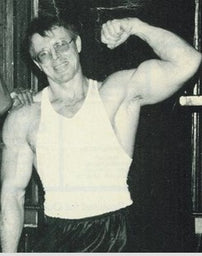There are many excellent ways to train, more ways than I have fingers on my hands. Examples include: antagonistic supersets, compound supersets, compound trisets, trisets with an antagonistic movement, giant sets, PHA or peripheral heart action, pre-exhaust, post-exhaust, rest-pause, 21’s, 1 ½’s, Slow-Motion reps, Super slow-Motion reps, drop sets (one, two, three or more drops), and down-the-rack dumbbell exercises, and descending reps and strip sets, super high rep sets (20-100), and the Vince Gironda method of 10 sets of 10 reps or 8 sets x 8 reps with 30 seconds rest between sets.
All are excellent ways to increase intensity and to work a muscle harder.While these training principles are great, they do not work forever. The muscles will adapt to the stress, and a plateau will occur. Then it’s time to change to a new way of working the muscle. Strength and bodybuilding expert Charles Poliquin says, “…the body can adapt to any exercise, training principle, or routine in as little as six workouts. Constant change is necessary to avoid sticking points and plateaus.”
MIND OVER MATTER
While all are great for innervating and pumping a muscle, there are draw backs too. On some workouts, it psychologically bothers some people because they are forced to use lighter weights. The amount of weight used has no effect on how much muscle they build. When bodybuilding, you should be trying to work the muscle as hard as you can, not focussing on how much weight you can lift. Heavy lifting often works the tendons and ligaments and connective tissue more than the muscles.
When using high intensity training principles, the muscle works harder even though lighter weights are used. Our muscles can’t tell if they are lifting 200 pounds or 100 pounds. They only know how hard they have to work to lift the weight. As Gunnar Sikk told me, “It’s not how much weight you use, it’s how your muscles respond to the weight.
You would be surprised at the number of champion bodybuilders I have interviewed who have said whether they prefer heavy, low rep training or lighter, high rep training who have said to me, “Well, I prefer heavy, low rep training but I’ve found I grow better when I do lighter high rep training.”Many bodybuilders enjoy lifting heavy weights. They especially like basic compound exercises, such as bench presses, and heavy cheat curls.
They just enjoy the challenge of lifting heavy iron and conquering it. Even though they may actually build more muscle mass when performing compound supersets, they feel dissatisfied psychologically because they have to use lighter weights.
ALTERNATES
Is there a way of training that prevents this problem? Or a method that allows a bodybuilder to work the muscle effectively and to use heavy weights at the same time? Yes! One method that allows a bodybuilder to lift heavy weights and stay strong throughout the entire workout, is by doing alternates. It’s like supersetting, but rather than taking no rest between exercises, you rest between one to two minutes between exercises.
Using the alternate principle, you alternate antagonistic muscle groups (such as biceps and triceps.) You can also alternate exercises for upper and lower abs, the flexors and extensors of the forearms, and the soleus and gastrocnemius of the calves.
This is by no means a new way of training. The great Sergio Oliva, a three-time Mr. Olympia champ, trained this way for years. When I went to Chicago in 1984 to watch “The Myth” train, he employed alternates in his workouts a lot. But he called what he did “combinations.” Canadian bodybuilder Joey Spinello was training his arms using the alternate principle back in the early 1990’s. He reported fantastic gains on his arms. Charles Poliquin claims it was he who taught the alternate principle to Joey.
BACKING UP A BIT
Many bodybuilders train their muscles with antagonistic supersets. Examples: Biceps and triceps, quadriceps and hamstrings, pecs and lats, and deltoid and traps, as well as the flexors and the extensors of the forearms, and the gastrocnemius and soleus of the calves, and the upper abs, and one for lower abs (lying knee-ins). When supersetting you take no rest between exercises. And perhaps one minutes rest between supersets.
Supersets give you a faster pace to your workouts. Supersets can give you a better pump to your muscles, improves endurance, raises your heart rate, and burns more fat. It also allows for shorter workouts. You spend less time in the gym because you are doing two exercises in the time you would usually do one.
There is a synergism when exercises are supersetted or alternated. The sum of the whole is greater than the sum of the parts. The combining of two exercises gives greater stimulation to the muscles than what one would expect from one exercise. Synergism can increase training intensity, efficiency, efficacy, and speed up muscle growth. By combining exercises in supersets of alternate fashion, you can expect greater growth. Plus, you can do this in less time than from regular straight set workouts.
For example, say you are supersetting pecs and lats. You could superset bench presses with wide-grip chins. You take no rest between exercises and only one minutes rest between supersets. You can work another muscle group while the previous one rests. You might then superset incline presses with bent barbell rows, dips with seated cable rows, and dumbbell flyes with cross-bench dumbbell pullovers. Depending on how advanced you are you do three to five supersets for each combination.
THERE IS NOTHING WRONG WITH ANTAGONISTIC SUPERSETTING
Antagonistic supersetting is one of my most favorite ways to train. Sergio Oliva, Dave Draper, Arnold Schwarzenegger, and Kalman Szkalak, used antagonistic supersetting a lot. Frank Zane and Franco Columbu also used antagonistic supersetting a lot in their workouts. Arnold said antagonistic supersetting gave the muscles of the body better flow; tying them together. It is a great feeling to have a pump in both the biceps and triceps at the same time.
Or both the pecs and lats, or the quadriceps and hamstring. Arnold also said that when supersetting your body becomes a unit; it flows and ties together. With the combined pump, and the muscles tying together, your create a need for oxygen in your bloodstream. And when your body adjusts to that, your energy level will go up. Then your heart and your cardiovascular system will work better.”
Arnold concluded by saying of super sets, “You can do more exercises in a shorter period of time, and you can get into the opposite movement—pushing and pulling. You train faster and become more accomplished. You will train muscles that are logically connected with other or muscles on the other side of the body, such as the front thighs and the back of the thighs. Supersets will give you the feeling of progress. You will get a double pump.”
In his fantastic book ‘Get Serious’, Dave Draper said of supersetting, “Superset training will improve your endurance, keeping your heart rate consistently higher through the workout. With the blood rate more constant to the muscle, I sense a greater purging of impurities, toxins, and lactic acid from the system. Supersetting provides the capacity for greater output as your endurance increases.Almost aerobic, it’s a more athletic way to train, allowing you to gain more physical fitness, and a more practical and useful body.
I find superset and triset workouts are more interesting, exciting, and involving of mind and body, certainly more fulfilling than single set routines. With opposing body part superset training you can move more quickly through the workout, exhausting the entire body, pushing to exhaustion one body part, but still have energy and endurance to work another. This provides momentum and rhythmic style, a greater burn in the muscles, and less workout interruptions.”
WHAT’S WRONG WITH TRAINING THIS WAY?
Nothing, except on your last sets you will definitely have to use less weight. Also, sometimes you fail from cardiovascular failure instead of muscular failure. What is the solution to this problem? Alternates. Rather than rushing back and forth between exercises for antagonistic or opposing muscle groups, you take a full one to two minutes rest between exercises.
Using the superset of bench presses and wide-grip chins as an example, you do a set of bench presses, wait a full two minutes, and then do a set of wide-grip chins. Then you rest two minutes before doing your second set of bench presses. This way you actually get more than four minutes rest between sets instead of none or 30 seconds to one minute.
This allows you to use the heaviest possible weights on your exercises. What’s amazing about performing alternates is you stay strong throughout the entire workout. The muscles never burn out. This is partly because whenever you do a set for an opposing muscle group, you give the muscle previously worked extra recovery. While most bodybuilders are skeptical of this, I can actually do more total reps of wide-grip chins if I do a set of bench presses first.
It’s the reason why you recuperate better after a long run if you walk around a little instead of just flopping to the ground. If I do wide-grip chins on their own I might do sets of 20, 18, 15, 10, 8. If I do bench presses before chins, my body feels lighter somehow and I might get 22, 19, 16, 12, 10 reps.
RESTING BETWEEN SETS
The longer you rest between each alternate combination, the stronger you will be. You can lift the heaviest weights possible, especially on bench presses, squats, bent over rowing, behind-the-neck pressing and barbell or dumbbell curls. On these exercises you can even rest three minutes between exercises. If you wish to go for more pump, reduce rest to one minute between exercises. I guarantee that you will love how strong you feel during your workouts when doing alternates.
You will feel strong throughout the workout even until your final exercises. The muscles never burn out. This concept of doing alternates works so well at maintaining strength that if I was coaching a power lifter at a contest I would have him perform a heavy set of bent over barbell rows six or seven minutes before each of his bench press attempts, and a heavy set of lying leg curls six or seven minutes prior to each squat attempt.
There are several advantages to doing alternates instead of regular supersetting. For one thing you do not get winded so you never have to end a set. This is because you’ll have cardiovascular exhaustion instead of muscular exhaustion. Then you can use much heavier weights because you are resting so long between exercises. This is understandable. Power requires rest. The longer you rest between sets, the more weight you can use. It’s the reason why weightlifters and power lifters rest five to ten minutes between sets when attempting to use heavy weights. Paul Anderson, the legendary strong man from the 1950’s and 1960’s, used to rest 10 minutes between sets and an hour between exercises.
Because you are working antagonistic muscle groups, you can use much heavier weights. The muscles don’t burn out like when you do compound supersets and trisets. Whenever you do a set for a muscle like the biceps, the triceps work to a small degree too. And when you do a set for the triceps, the biceps work to a small degree too. It is this small amount of work that lets the muscle recover better so you can use heavier weights.
ALTERNATE TRAINING FOR ARMS
Alternates work well for any opposite muscle groups, but they seem work especially well for biceps and triceps. This is also true if you stress the negative as you do curls and extensions and dips. John Parrillo says, “…don’t just lower the bar down on barbell curls, pull the bar down using the power of the triceps. This pulling down action has several benefits. For one it keeps the muscle under constant-tension. The harder you pull the bar down on barbell curls using the power of the triceps, the more the biceps are under tension at the start of each repetition.
Another benefit to pulling the bar back to the bottom on any type or curl using the power of the triceps, is you give the muscle pre-stretch. The more a muscle stretches at the bottom of a repetition, the harder it can contract at the finish. That’s a law of bodybuilding. A harder contraction means more overload to the working muscle. Greater overloads adds up to more muscle growth.
INNERVATION TRAINING
Another benefit to pulling hard with the opposing muscle group is it “teaches” bodybuilders how to perform their exercises more correctly. This allows for maximum muscle stimulation. A higher level of awareness during a set is necessary to innervate the muscle to the max during a set. Feeling ache, burn, muscle tension, fatigue and contractions in the muscle, and to pump the muscle to the max too.
By using the sensory feel of a muscle stretch and contract, teaches you how to work and innervate a muscle. The feedback you get during exercises will tell you if you are doing your exercises. Innervation training asks a simple question: When you do a set do you feel the muscle working or not? If you feel a burn, ache, constant tension, and contraction in the muscle, and you get a great pump, your form is correct. If you do not, your form is off. You are not training correctly. End of story.
If you train by sensory feel, you will know if you are cheating too much, or using secondary muscle groups to help lift a weight. If you train by sensory feel you will know if you are isolating and stimulating and innervating a muscle. The muscle will not be overloaded, maximally stimulated or pumped. If you do heavy barbell curls and all you feel is forearms, delts, and traps, you know you are cheating too much. The weight is too heavy for proper form.
The weight is so heavy all you can do is focus on lifting the weight, not on working the muscle. All your concentration and effort is on lifting the weight, not working the muscle. The working muscle—in this case, the biceps—gets no stimulation, overload, or pump.
EXPERIMENT TO SEE WHAT WORKS
I have found that sometimes you have to experiment and try different things. Try different grips, body positions, workloads, and take things to the extreme to discover the middle-ground. PGA golfer Lee Trevino said that sometimes he would go to the course and be fighting a hook on the practice range (the bar goes extreme from right to left). To get his ball to go straighter, he had to open his stance and weaken his grip to hit the biggest slices he could. After he hit a couple dozen slices, he would assume his usual grip and stance. He would then hit his typical fade where the ball went just a few feet from left to right.
The same is true of barbell training. Go to extremes at both ends of the spectrum. From ultra-strict in a robotic-sense, to ultra-loose and extreme cheating. Let feel guide you, and you will find a happy medium between the extremes. Find how to work a muscle for greatest muscle innervation and stimulation. On barbell curls notice the difference between holding the bar in the fingers with the thumbs wrapped around the bar, and holding the bar in the palm with the thumbs on top. Keep your wrists locked straight, the shoulders down and back, the chest arched, and the elbows in tight to the body.
Now when you curl the biceps do most of the work. You’ll see that only the forearms move. Contraction occurs at 10 o’clock, not 12 o’clock, so there is no need to raise the elbows up. With the wrists locked, there is no way for the bar to fall into the shoulders at the top, taking the tension off the biceps. You want your fully contracted biceps to get in the way.
TRIAL & ERROR
Once you learn how to do barbell curls with a moderate weight, then you can discover how to use heavier weights. You can do what Vince Gironda called “creative cheating.” You’ll lift the bar in a way in which Dave Draper called “body rhythm” and “thrust.” You are cheating but the targeted muscle still does most of the lifting. Through trial and error, you will discover the methods which best for you. By re-evaluating your performance as you train, and comparing the feedback you get from doing an exercise, you can make adjustments to your form.
You will find the groove and performance for each exercise for greatest muscle stimulation. As long as you see your body as a bio-feedback machine, and you let “feel” be your teacher, you will never do the exercise wrong. You will place “overload” on the targeted muscle group.
Alternating exercises for biceps and triceps is a fantastic way to build muscle mass. Say you want to alternate barbell curls and decline EZ-bar triceps extensions. There are several advantages to doing alternates versus supersets. For one thing you don’t become winded and so you never fail from cardiovascular failure.
You can use heavier weights because you rest two minutes between exercises, not 30 seconds when doing supersets. The longer you rest between sets, the stronger you will be. Power and strength need rest. The longer you rest between sets, the stronger you will be.
Unlike supersetting, with alternates the muscles never burn out or become too exhausted to lift a heavy weight. Using the alternate principle exhaustion is never a concern. Not only are you giving a muscle rest between sets, whenever you do a exercise for biceps, it helps your triceps recover faster. Whenever you do a set for the triceps, it helps the biceps to recover. It’s like a double-whammy for your muscles! Longer rest between sets to have more recovery, and alternating opposing muscle groups for more recovery too.
TRAINING
When doing alternates I would suggest you split the body and train either five days on-two days off, or two days on-one day off. You could split your body as follows:
Day 1: chest and lats, abs, calves
Day 2: quads, hamstrings and lower back (deadlifts)
Day 3: rest
Day 4: delts and traps, calves
Day 5: biceps and triceps, forearms, abs
Day 6: rest
Day 7: rest or repeat cycle, chest-lats, abs, calves
Unless you are some Heavy-Duty whacko, I suggest between 12 to 16 sets per muscle group. That’s three to four alternate combinations of alternate exercises of three to four sets. Since the emphasis is on power, keep reps in the 5 to 8 rep range. Except for the last combination, when you might do one exercise for four reps followed by a second exercise for the alternate muscle group after a two minute rest of four reps. If you are doing alternate combinations for four sets your reps might be 1 x 8. 1 x 7, 1 x 6, 1 x 4-5, pyramiding up in weight each set.
A sample alternates arm routine might be:
Barbell curls 1 x 20 (warmup), 1 x 10, 8, 6, 4-5
Decline close-grip bench presses 1 x 20 (warmup), 1 x 10, 8, 6, 4-5
Alternate dumbbell curls 1 x 8, 6, 6, 4-5
Decline EZ-bar extensions 1 x 8, 6, 6, 4-5
Barbell preacher curls 1 x 10, 8, 6, 5-6
Triceps pushdowns 1 x 10, 8, 6, 5-6
Hammer curls 1 x 8, 6, 5-6
French presses 1 x 8, 6, 5-6
EZ-bar reverse-curls 1 x 10, 8, 6, 5-6
Seated wrist curls 1 x 25, 20, 18-20, 1 x 15
CONCLUSION
Give alternates a try. I think you will be surprised at how much heavier you can train and how strong you stay throughout the entire workout.
Please Let Us Know If You Enjoyed This Article.
Your Feedback Is Important To Us
Disclaimer: This content is for informational purposes only and is not meant as medical advice, nor is it to diagnose or treat any medical condition. Please consult your physician before starting or changing your diet or exercise program. Any use of this information is at the sole discretion and responsibility of the user.













